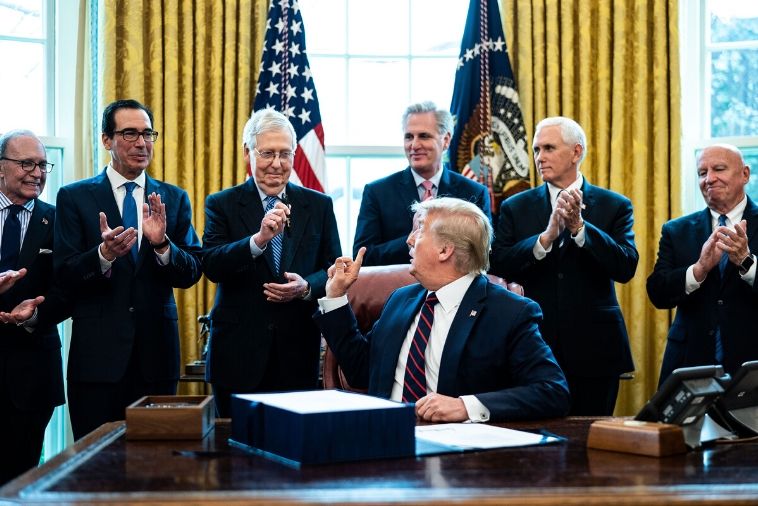House Democrats passed a largely symbolic bill on May 15 rolling back two controversial tax provisions that had been slipped into the CARES Act, the $2 trillion stimulus law that Congress passed in March with overwhelmingly bipartisan support. The two tax provisions, which remove caps on individuals’ and businesses’ ability to write off net operating losses, are expected to deliver a $160 billion windfall to the wealthiest Americans, disproportionately benefiting hedge fund and real estate investors.
While the repeal effort will likely be dead upon arrival in the Senate, where it has no support among Republicans, the Democrats’ move raises a question: How did these two massive tax breaks for the very rich get slipped into the CARES Act in the first place?
TIME’s analysis of drafts of the bills and lobbying disclosures, along with interviews with half a dozen staffers and lobbyists, show that the provisions originated with Senate Finance Committee Chairman Chuck Grassley’s office, which was working with other Republicans on the committee, and were lobbied for heavily by the real estate industry, including a prominent real estate trade group, of which Jared Kushner’s family’s company is a member.
The National Multifamily Housing Council (NMHC), which represents the apartment industry, spent $1.4 million in the first quarter on lobbying myriad power centers, including Congress and the Executive Office of the President. It listed one of the two tax provisions among its many lobbying targets.
Jared Kushner’s family’s company, Kushner Companies, is a member of NMHC’s advisory committee, according to the organization’s website. That membership appears to be the lowest level of membership and requires an annual fee of $5,000. The NMHC website also lists Avi Lebor, Kushner Companies’ director of acquisitions, as the contact for the company on the membership directory. Lebor was in prison with Kushner’s father and joined Kushner Companies after they were both released, according to Bloomberg. The Trump Organization, which will also benefit from the tax provisions, is not publicly listed as a member of NMHC.
On May 13th, just two days before Democrats voted to repeal sections of the CARES Act, NMHC hired an outside lobbying firm, Nixon Peabody, to lobby in part on “corrections to the CARES Act,” according to disclosure filings.
Both the National Retail Federation (NRF), the trade association representing the retail industry, and the Commercial Real Estate Development Association (CREDA), an organization for real estate developers, also listed “net operating losses” among their lobbying targets in the first quarter. The NRF spent nearly $1.6 million, while CREDA spent $312,000. The International Council for Shopping Centers, the trade association for shopping malls and retail, spent $320,000.
According to one Grassley aide, their office included the provisions in a draft of the CARES act without consultation from the White House. Democrats, who say they were not lobbied about the provisions, told TIME that they knew the provisions were in the bill, but did not understand the extent of their impact until after the law had passed. Due to the rapid timeline of the bill’s passage, a lack of a cost estimate for the provisions, and debates over more higher profile issues, like ensuring the inclusion of expanded unemployment insurance, Democratic aides said the tax breaks were simply not a key part of the negotiations.
But those two provisions, which amount to just twelve pages in a more than 800-page law, now carry outsized weight. Indignation over huge tax cuts to the very rich are fueling the first major wave of anger towards Washington—part of a bigger outcry as fallout from the coronavirus pandemic reveals systemic inequities across the country.
“I think Congress was directed more at ‘lets shovel a whole bunch of dollars into the economy to stem some of the bleeding’ and I don’t think they focused as much as they could have on where Congress is shuffling those dollars,” says Steven Rosenthal, an expert at the Tax Policy Center, a non-partisan think tank and an outspoken critic of the provisions. “Too much of the relief Congress has parceled out will end up in the hands of millionaires and people who don’t need the money.”
Tax provisions will benefit ‘the least needy of our society’
In tax-code language, a net operating loss occurs when more money is lost than gained—in other words, when businesses or individuals have more deductions than taxable income. The two provisions in question allow companies and individuals to write off business losses they accrued before the pandemic hit, along with the losses they will accrue during the crisis. Both provisions also did away with previous caps on the total amounts that companies and individuals could write-off.
The first provision, Section 2303, deals with corporate taxes. It allows corporations to offset all losses for tax refunds going as far back as 2013. Under the 2017 Tax Reform Act, corporations could only offset 80 percent of taxable income with these losses, and they could only be applied to tax returns going forward. The CARES Act removes that limitation until 2021, and allows companies to offset losses retroactively for up to five years for the years 2018, 2019, and 2020.
The second provision, Section 2304, is more controversial. It essentially extends the same terms to non-corporate taxpayers, known as “pass through” businesses. Under the 2017 tax law, owners of these businesses could only deduct up to $500,000 (for a couple filing jointly) to offset losses in their non-business income. The CARES act strips away that $500,000 cap until 2021 and enables taxpayers to file retroactively on losses, as far back as 2013.
While majority of businesses in the United States are organized as pass-throughs, this provision would not benefit most mom and pop shops: most small business owners would never amass up to $500,000 in non-business income. As the National Taxpayers Union Foundation wrote in a blog post defending these policies, “the limit only applied to high-income filers in the first place.”
Critics of the provisions say they are unnecessarily costly and disproportionately benefit those—millionaires and billionaires—who least need relief. “Sure, [these taxpayers] suffered a real investment loss,” says Rosenthal, “but these are the least needy of our society.”
Tax experts add that it’s not just the wealthiest tax payers that will see a windfall from the provisions. Real estate investors and hedge fund managers will benefit specifically because their business models rely heavily writing off losses like depreciation. Both the Trump Organization and Kushner Companies, for example, could see a significant windfall from the provisions. (A New York Times investigation from 2016 found that in 1995, Trump filed losses so great he could have legally avoided paying income taxes for up to two decades, in large part because of the net operating loss provision).
“Thanks to the way real estate is positioned, they are the best positioned to take advantage of [this provision],” says Steven Dean, Faculty Director of the Graduate Tax Program at New York University Law School. “The reason that real estate investors love NOLs is that they have enormous losses that don’t relate to any actual economic losses. If those NOL provisions are relaxed and they can carry them back or forward…they win.”
Both Grassley’s office and outside advocates who pushed for the provisions argue that the provisions will help all businesses keep staff on payroll during an uncertain economy, and accuse Democrats of playing up the Joint Committee on Taxation’s analysis for political gain. They also argue that allowing corporations to retroactively benefit from net operating losses is similar to laws Congress passed with bipartisan support during the 2009 Great Recession, and in the aftermath of Hurricane Katrina in 2005.
“We didn’t pick winners and losers,” Grassley wrote in an op-ed on Fox News last month after the JCT analysis came out. “This partisan attack threatens the relief intended for businesses in every industry across America. The attempt to paint this tax provision as a boon for real estate and hedge fund investors completely misses the mark.”
‘This was a Republican provision,’ but Democrats missed its significance
The proposed language for these provisions was included in the initial suggestions for tax relief Grassley released on March 19th, and in every subsequent draft. The House Democrats’ March 23 version includes the first provision on corporations but not the second provision.
“This was a Republican provision. It was included in Republican proposals from the beginning, and Republicans pushed for it during the CARES Act negotiations,” Ashley Schaptil, a spokesperson for Sen, Ron Wyden, the highest ranking Democrat on the Senate finance committee – who negotiated portion of the bill – said in a statement to TIME.
When asked about lobbying for these policies, aides to the top Democrats on the relevant committees said they were not lobbied. One Grassley aide recalled receiving “thousands of e-mails” when drafting the legislation but could not recall a particular group pushing for these provisions in particular. “It wasn’t done for a group or out of anyone’s particular interest,” says one Grassley aide.
Lobbying disclosure forms show that more than a dozen groups spent a total of $5.9 million in the first quarter of 2020 lobbying both Congress and the White House on provisions dealing with net operating losses. That figure does not include the millions of dollars by other groups that pushed for broad tax relief. In a March 18 letter to Trump, House Speaker Nancy Pelosi, and Senate Majority Leader Mitch McConnell, 100 trade groups asked for the provisions to be included.
Matthew Turkstra, who directs tax policy at the Associated General Contractors of America, was among those who lobbied for both provisions. He said the limits on offsetting total net operating losses adversely impacts the construction industry, which is volatile to begin with, and noted that the business community generally supported these provisions, and that they were explicitly included in every draft, despite Democrats’ insistence that Republicans snuck them in. “I don’t think there was any cloak and dagger stuff going on here,” he says.
Neither the NMHC or NAIOP were immediately available for comment.
Their passage was an oversight, Democrats say
Both Republican and Democratic aides familiar with the committee negotiations say these provisions never really came up for extended debate. When the debate did turn to taxes, Democrats pushed to remove downward attribution and transition tax overpayments – two provisions they claimed benefit corporations and bore no relation to the pandemic. Since Republicans were arguing that net operating losses will provide liquidity to businesses, Democrats felt they had less leverage to push back – particularly after Republicans agreed to include expanded unemployment insurance.
But, Democrats acknowledge, they were also flying somewhat blind. A finance committee aide say they did not receive the cost of the provision until Monday, March 23, after the final deal had been reached with committee Republicans. Even then, they lacked the distributional analysis showing the extent to which it would skew to the wealthy.
“It was a surprise to us when we saw the loss in revenue,” said one Democratic aide. “If you look at the distribution and you look at the amount of funds that went to each provision we probably would have pushed harder.” (Aides to Grassley said Democrats had access to the scores when Republicans did and they can always ask for scores independently).
Other Democrats say they were unaware of the score at all.
“The tax provisions to some extent, before we knew the score, kind of flew under the radar,” said one Senate Democratic aide. “It was not surprising Republicans were pushing business tax cuts.” Another Congressional aide effort recalled how difficult it was to plow through the bill such a short amount of time without a JCT score and said it was only after the bill passed that the provision’s outsized impact came into focus.
In the weeks after the bill passed, two lawmakers, Senator Sheldon Whitehouse and Rep. Lloyd Doggett, realized the cost and distribution of the tax cuts would be broader than the initial assessment, and requested an analysis from the Joint Committee on Taxation, which they received on April 14. By April 23, over a third of Democratic Senators had signed onto the effort to repeal the provisions; they were joined by over 40 of their colleagues in the House. On May 8, 215 outside organizations wrote to Congress demanding a repeal, and the House inserted the fixes into their bill four days later.
What had begun as an arcane provision had evolved into a raging partisan debate.Correction, May 19
The original article can be found here:
https://time.com/5836487/real-estate-tax-break-coronavirus-kushner/















